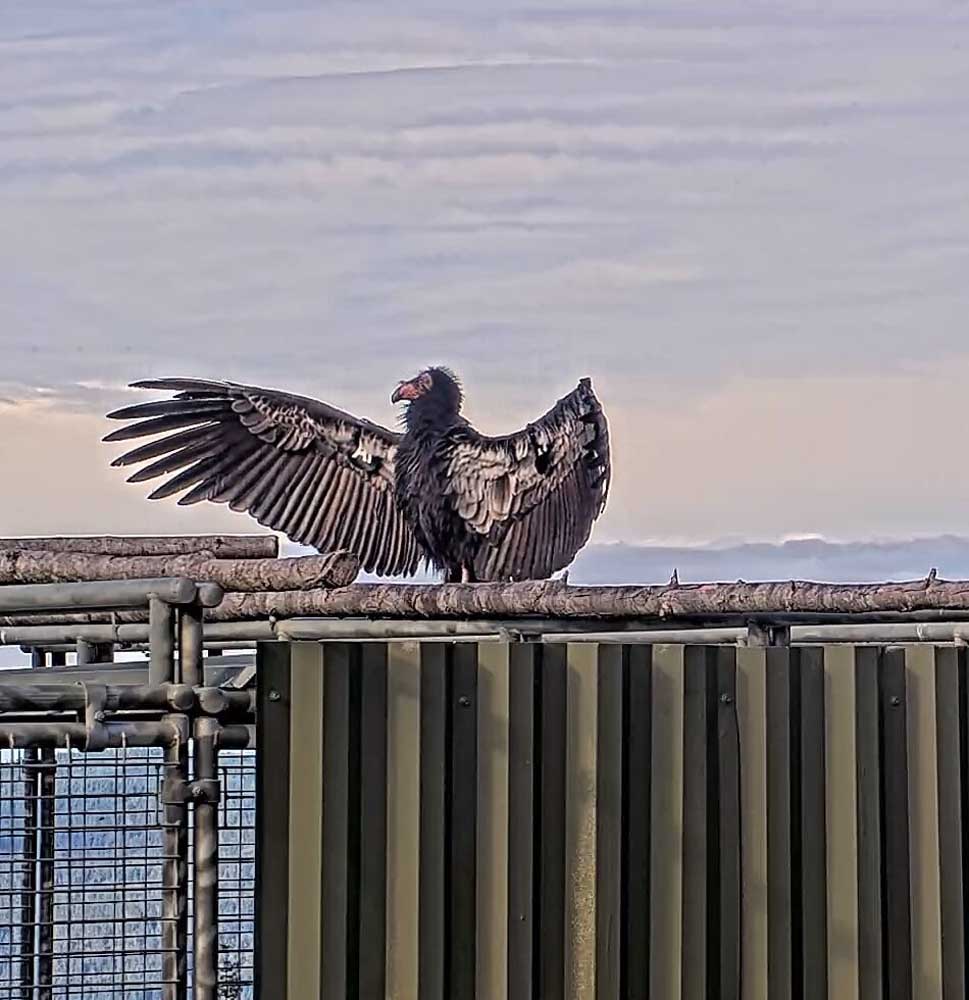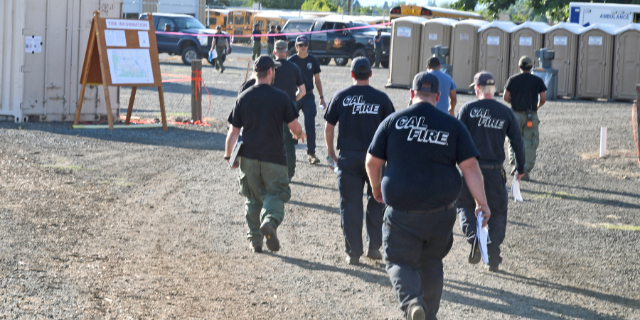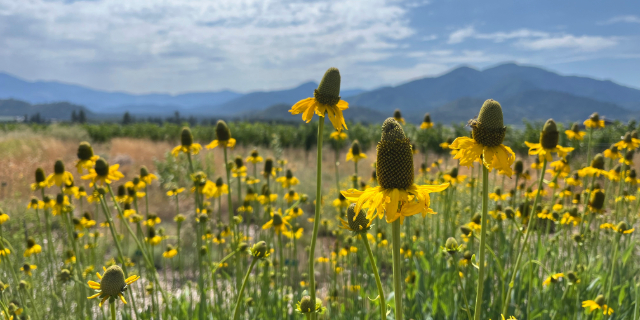Freedom to fly: Three more California condors join Yurok Redwood flock
Published 11:30 am Sunday, November 12, 2023

- A condor "sunning" at the Yurok Tribe release site. They are warming their bodies in preparation for flight, and his posture may also help rid them of parasites.
And they’re off! Well, not exactly.
Trending
When the door to freedom slid open last Wednesday, three young California condors slated for release along the Klamath River in Northern California didn’t budge.
Finally, after a few false starts, the two females joined the free-flying condor flock who were feeding just outside the enclosure. The third condor, a male, chose to join the others the next day, bringing the Yurok Redwood flock up to 11 birds.
Witnessing these ancient giants with their nearly 10-foot wingspans bursting forth into the sky for the first time is impressive, but in reality, a “soft release” where the birds are let out at their own pace goes smoother, potentially preventing inexperienced fliers from becoming caught up in wind currents that could transport them miles away.
Trending
Those watching the action on the Yurok Tribe’s live condor cam (yuroktribe.org/yurok-condor-live-feed) enjoyed the show.
Initially, a “mentor” bird who’d been penned up with the new cohort exited the enclosure. Next, the female wearing wing tag B2, named Pey-cheek, or “Upriver,” walked out and sidled up to the carcass buffet to feed alongside her new flockmates.
Twenty minutes later, “B0 came in like a wrecking ball,” knocking another condor off the carcass she’d been feeding on, said Tiana Williams-Claussen, director of the Yurok Tribe Wildlife Department. B0 is a female named Pey-gel, or “Fighter.”
A tussle ensued, though it was over almost as fast as it had begun. While often displaying gentleness toward each other, condors can also behave like street fighters — especially when food is involved.
When B1, a male named Pue-leek, or “Downriver,” decided to join the party the next day, he was knocked around some but recovered nicely, perching on top of the enclosure to survey his new world with B0 and B2 sitting nearby. The trio continues to hang out together.
The Northern California Condor Restoration Program, a partnership between the Yurok Tribe and Redwood National and State Parks, received all three 18-month-old condors from the Los Angeles Zoo on Oct. 9.
Last year, the NCCRP released the first eight critically endangered condors to fly over the skies of Humboldt and Del Norte counties in more than a century. Williams-Claussen said the newly released birds are “exhibiting positive behaviors, such as eating, soaring and resting in protected roosts.” So far, they’ve traveled 52 miles from the release site near Klamath, California. Capable of flying a few hundred miles a day, eventually they’ll soar into Oregon.
While acclimating to the region before their release, the new cohort received frequent visits from the highly social, free-flying birds. NCCRP biologists say the older birds will now help new flockmates become familiar with their new environment and develop critical flight skills.
Condors are enigmatic beings well-known to be highly intelligent and playful. They have language, live over 60 years, sometimes switch mates and even raise chicks in threesomes. They also display impressive reasoning capabilities. A now-famous condor called “Puff Daddy” had a soda can stuck on his beak — so he flew back to a release enclosure, calmly walked in and offered himself up to the humans for capture.
Back in 1982, only 23 condors were left in the world. Williams-Claussen explained how decades of poaching and habitat loss, deliberate poisoning and chemical pollution took a terrible toll after Europeans settled the West. Condors don’t reach sexual maturity until 6 to 8 years old, and then, only produce one chick every two years. In the same time frame, an eagle might raise five chicks.
With such a slow breeding rate, they couldn’t recover without help.In 1987, these few survivors were captured and placed in breeding programs that proved to be so highly successful that releases back to the wild began just a decade later. Now there’s more than 500 condors in the world — with over 300 flying the skies of Arizona, California, Utah and Baja California, Mexico.
Condors face many challenges
“The biggest barrier to establishing self-sustaining populations is lead poisoning, which currently causes 50 percent of condor mortality,” Williams-Claussen said. “Condors are the canaries in the coal mine.”
An elk recently poached in the redwoods was likely the Yurok condors’ first experience with locating and consuming wild food. Just days later, five of the eight birds captured for routine biannual health checks tested positive for lead, and one was hospitalized and received chelation therapy.
While that bird recovered, the incident underscores the harsh reality condors face.When condors — and many other wildlife species — ingest lead found in gut piles left behind by hunters, they can suffer a slow and agonizing death. Upon impact, lead ammunition fragments into hundreds of small pieces and it takes only a tiny bit to kill a condor. Lead fishing weights also poison animals.
Still, Williams-Claussen said there’s cause for hope, and it’s all about education. “We developed a ‘Hunters as Stewards’ program, and based on post-outreach surveys, as many as 95% of hunters indicated they would voluntarily make the switch to non-lead ammunition.”
Another serious threat is the Highly Pathogenic Avian Influenza (HPAI) virus that killed 21 condors in the Arizona/Utah condor population earlier this year. The U.S. Fish and Wildlife Service worked with multiple partners to develop an HPAI vaccine, and while still at the L.A. Zoo, this newest cohort of Yurok condors were the first to be vaccinated for HPAI and then released into the wild.
Facing these obstacles makes each condor’s life valuable beyond measure, Yurok Tribe members say, and with such unique personalities, each of the 11 Yurok birds is loved by the many condor enthusiasts worldwide who follow their progress. The condors, called “Prey-go-neesh” by the Yurok, also represent a bridge between native and non-native communities, and as each bird becomes known, Williams-Claussen names them.
“The Yurok world and thus the Yurok language is guided by our relationship with the land,” she said. “For the Yurok and other tribal people who share the Klamath River, the river and its tributaries are like the blood in our veins.”
Williams-Claussen explained how condors follow the rivers, mountains and the valleys carved by the waters. “They travel back and forth along these corridors … cleaning up the earth and carrying nutrients wherever they go.”
Release day connotations
On the release days last week, the names of the newly freed birds held special meaning, Williams-Claussen said.
“The first out of the gate” was B2,” she noted. “Her name, Pey-cheek, means ‘Upriver’ and connotes the start of the journey. The waters begin here and flow to feed the rest of our world.”
B1’s name Pue-leek “means ‘Downriver’ and encompasses the flow of water and life to the north along the coast,” Williams-Claussen said.
B0’s name is Pey-gel, whose father, “Topa Topa,”
is the oldest living California condor at nearly 58 years
old.
“Pey-gel’s name took a different direction and means ‘Fighter,’” Williams-Claussen said.
Pey-gel indeed came out fighting, tussling with the elder cohort last Wednesday.
“Though suitably chastised by her elders, that bold and fighting spirit is worth commemorating in her name. We pray that it carries her far in this life,” Williams-Claussen said.









